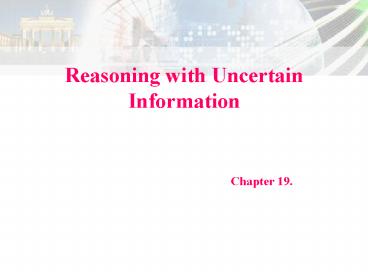Reasoning with Uncertain Information Chapter 19' - PowerPoint PPT Presentation
1 / 26
Title:
Reasoning with Uncertain Information Chapter 19'
Description:
(B (BAT_OK), M (MOVES) , L (LIFTABLE), G (GUAGE)) Joint Probability (True, ... The probability that the block is not liftable given that the arm does not move. ... – PowerPoint PPT presentation
Number of Views:40
Avg rating:3.0/5.0
Title: Reasoning with Uncertain Information Chapter 19'
1
Reasoning with Uncertain Information
Chapter 19.
2
Outline
- Review of Probability Theory
- Probabilistic Inference
- Bayes Networks
- Patterns of Inference in Bayes Networks
- Uncertain Evidence
- D-Separation
- Probabilistic Inference in Polytrees
3
19.1 Review of Probability Theory
- Random variables
- Joint probability
Ex.
4
19.1 Review of Probability Theory
- Marginal probability
- Conditional probability
- Ex. The probability that the battery is charged
given that the arm does not move
Ex.
5
19.1 Review of Probability Theory
6
19.1 Review of Probability Theory
- Chain rule
- Bayes rule
- Abbreviation for
- where
7
19.2 Probabilistic Inference
- The probability some variable Vi has value vi
given the evidence ? e.
8
Statistical Independence
- Conditional independence
- Mutually conditional independence
- Unconditional independence
9
19.3 Bayes Networks
- Directed, acyclic graph (DAG) whose nodes are
labeled by random variables. - Characteristics of Bayesian networks
- Node Vi is conditionally independent of any
subset of nodes that are not descendents of Vi.
10
Bayes Networks
- Prior probability
- Conditional probability table (CPT)
11
19.3 Bayes Networks
12
Inference in Bayes Networks
- Causal or top-down inference
- Ex. The probability that the arm moves given that
the block is liftable
13
Inference in Bayes Networks
- Diagnostic or bottom-up inference
- Using an effect (or symptom) to infer a cause
- Ex. The probability that the block is not
liftable given that the arm does not move.
(using a causal reasoning)
(Bayes rule)
14
Inference in Bayes Networks
- Explaining away(??)
- B explains M, making L less
- certain
(Bayes rule)
(def. of conditional prob.)
(structure of the Bayes network)
15
19.5 Uncertain Evidence
- We must be certain about the truth or falsity of
the propositions they represent. - Each uncertain evidence node should have a child
node, about which we can be certain. - Ex. Suppose the robot is not certain that its arm
did not move. - Introducing M The arm sensor says that the
arm moved - We can be certain that that proposition is either
true or false. - p(L B, M) instead of p(L B, M)
- Ex. Suppose we are uncertain about whether or not
the battery is charged. - Introducing G Battery guage
- p(L G, M) instead of p(L B, M)
16
19.6 D-Separation
- ? d-separates Vi and Vj if for every undirected
path in the Bayes network between Vi and Vj,
there is some node, Vb, on the path having one of
the following three properties. - Vb is in ?, and both arcs on the path lead out of
Vb - Vb is in ?, and one arc on the path leads in to
Vb and one arc leads out. - Neither Vb nor any descendant of Vb is in ?, and
both arcs on the path lead in to Vb.
17
19.6 D-Separation
- I(G,LB)
- I(G,L)
- I(B,L)
18
Inference in Polytrees
- Polytree
- A DAG for which there is just one path, along
arcs in either direction, between any two nodes
in the DAG.
19
Inference in Polytrees
- A node is above Q
- The node is connected to Q only through Qs
parents - A node is below Q
- The node is connected to Q only through Qs
immediate successors. - Three types of evidence.
- All evidence nodes are above Q.
- All evidence nodes are below Q.
- There are evidence nodes both above and below Q.
20
Evidence Above (1)
- Bottom-up recursive algorithm
- Ex. p(QP5, P4)
(Structure of The Bayes network)
(d-separation)
(d-separation)
21
Evidence Above (2)
- Calculating p(P7P4) and p(P6P5)
- Calculating p(P5P1)
- Evidence is below
- Here, we use Bayes rule
22
Evidence Below (1)
- Top-down recursive algorithm
23
Evidence Below (2)
24
Evidence Above and Below
?
?-
25
A Numerical Example (1)
- Diagnostic reasoning
26
A Numerical Example (2)
- Other techniques
- Bucket elimination
- Monte Carlo method
- Clustering































